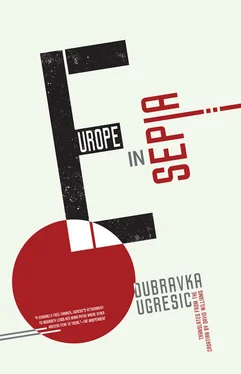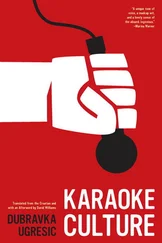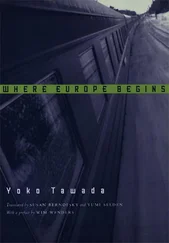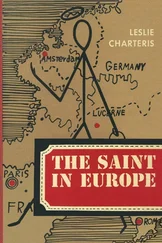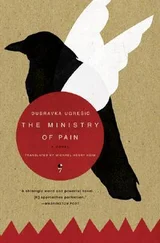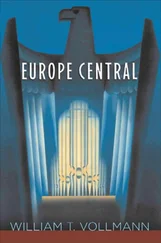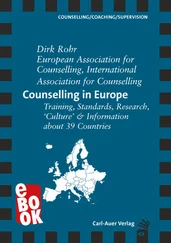Most people associate “visual art” with strong (“scandalous”) authorial personas, Damien Hearst being a case in point. Building his or her authorial personae — conscious that they live in the celebrity culture that is ours, a modern version of polytheism — many artists, consciously or unconsciously use self-beatification, self-divinization (one of the forms of canonization in celebrity culture), and thus exploit the religious potential of the artistic act. It’s how Marina Abramović turned MoMA into Međugorje (or Lourdes), herself into Our Lady, and thousands of visitors into believers and pilgrims for the duration of her three-month project, “The Artist Is Present.” Dressed as the Virgin Mary full of grace, Abramović lowered her healing gaze onto visitors, flickered her eyelids, and occasionally let a tear fall from her eye. Reporting that they had undergone a cathartic experience, many visitors also shed tears. It turns out that today’s celebrated authors are indeed modern saints, with devotees who follow in the footsteps of their teacher, cementing his or her canonical place on the artistic map of the world, spreading his or her artistic vision. At the same MoMA exhibition, young performers and devotees of Abramović’s artistic teachings reactivated her early performance works, in the self-same way that groups of amateur faithful perform the nativity scene at Christmas, or more masochistic Catholics tread Jesus’s path to Calvary. The repetition of Abramović’s performances by younger artists was in the service of the canonization of the authorial persona of Marina Abramović, not the affirmation of a particular form of artistic expression, in this case, performance art. Moreover, the repetition of a live artistic act, such as performance art, is in contradiction with the very essence and purpose of the form. Repeated, performance art becomes an artistic souvenir. When an anonymous young visitor to Abramović’s MoMA show did her own little Pussy Riot and undressed — an attempt to display her devotion to the great artist — the museum guards immediately led her away. Why? Because the heathen have never been allowed to act out any instinct that might disturb the religious ritual, in this case that of self-beatification. But then, Marina Abramović is a woman and an artist, aware of the powerful world of stereotypes, and her own position within it. Women artists are rarely canonized and even more rarely proclaimed saints. Conscious of this, Abramović decided to take matters into her own hands.
Buying a book by Haruki Murakami, many readers throughout the world first and foremostly buy entry to the heaving mass of fans of this “literary saint,” then they buy a story about global literary success, and then also into one about community. In the symbolic act of buying a book they create community with other readers throughout the world, a kind of spiritual pilgrimage. There, perhaps, lies the mystery of cultural conformism, the answer to the question of why most people buy the things most people buy.
The purchase of a symbolic, “spiritual” product (a book, film, album, video game, etc.) is actually contact with another consumer, the creation of belonging, the overcoming of loneliness. It is the principle, it seems, on which culture markets flourish, whether those of children, teenagers, adolescents, or adults. .
The market, it seems, has no need for an original, romantic-style genius, but for an appropriately “off-the-rack” author, someone who in the celebrity culture in which we live will substitute excellence and genius with an authorial persona, an essence coupled with good design. Because it appears the author expired the moment the idea of the “mad genius” and the “singularity of the artistic act” were expunged from the social consensus, the populist idea of “stand in line and have your shot” taking their place. Beda Foltin, the hero of Karel Čapek’s final, unfinished novel The Composer Foltin, would today not incite the moral opprobrium he did in the time the novel was set. Foltin, who fancies himself a talented composer and goes about stealing others’ motifs to create an opera he calls Judith (a musical Frankenstein), would simply be dissed as a crap DJ. In a culture of remix, cut and paste, computer programs, fan fiction and the people who write it, twitter, cell-phone novels, self-publishing, and anonymous authors and editors, a culture in which the absolute absence of responsibility prevails, Čapek’s moral message would be met by general incomprehension.
One mystery, however, remains: Whence the urge in each of us to try our creative hand, to find our listeners, viewers, and readers? Whence the hatred and envy of those who achieve greater success than we do? The millions of frustrated individuals — writers, editors, painters, musicians, directors, the malicious creeps and sarcastic douche bags, the self-appointed censors and critics, the envious, the wannabe artists hungry for fame? And whence the righteous, convinced fame has unfairly passed them by, the copiers, imitators, plagiarists, self-appointed assessors of others’ talent, the sickos fantasizing about their future masterpieces, the art lovers hiding penknives in their pockets, just waiting to slash an artist’s canvas? Whence the millions of amateurs who plaster themselves all over the Internet, with their films, songs, sketches, their monologues on painting, literature, and philosophy, seeking attention and respect for the simple fact that they’re there on our computer screens, in front of our noses, for the mere fact that they, well, exist? The terrifying armies of devotees and haters? The vicious jealousy of the creative act? Could it be because the creative work — at least as it stands in the current social contract — is a potential ticket to eternity; to a street bearing our name, a poem in a future anthology?!
“One of the books that caused great harm was James Joyce’s Ulysses , which is pure style. There is nothing there. Stripped down, Ulysses is a twit.” This was Brazilian global superstar Paulo Coelho’s recent take. “I’m modern because I make the difficult seem easy, and so I can communicate with the whole world,” he claimed.
The Peter Shaffer drama Amadeus (1979) and the Miloš Forman film of the same name (1984) rank among the most significant modern texts on the unbearable lightness of genius and the murderous weight of envy. Amadeus is the story of Salieri and Mozart’s putative rivalry, or more to the point, Salieri’s maniacal obsession with Mozart’s genius, one that will drive Mozart to the grave, and Salieri to madness. Six years older than Mozart, Salieri outlived him by a full forty years. Antonio Salieri was the director of the Italian opera at the Habsburg court, an esteemed European opera “manager” (Vienna, Rome, Paris), a popular composer of his time, the Austrian emperor’s Kapellmeister , a music teacher and “coach” to many greats, Franz Schubert, Ludwig van Beethoven, and Franz Liszt among them. His music disappeared with his death. Thanks to Shaffer’s drama, and more so, Forman’s film, Antonio Salieri has undergone a modest artistic rehabilitation. Every year his hometown of Legnago organizes the Salieri Opera Festival, the local theater even bearing his name. Academic interest in his work has generated demand for its performance: Here and there his operas are returning to repertoires. So yeah, Salieri was an author, and Mozart was an author. Who knows, maybe future generations won’t be able to tell the difference between the two. Or maybe they will, but simply won’t care.
History, cultural history too, heaves with ironic turns. Is the platitude about the inevitable triumph of artistic justice to be believed? Questions of justice are usually settled by the victor’s hand. In this light, it’s entirely possible that James Joyce will one day figure in a Paulo Coelho biography as a footnote, with Joyce glossed as a minor Irish writer who once wrote a book Paulo Coelho determined had done great harm to literature. We don’t really believe that something of the sort might happen, but not because James Joyce is an Irish cultural icon, but rather because he’s a golden goose for Irish tourism. Whatever the case, that fact remains that the untalented are feistier than the talented, the stupid feistier than the smart, the evil feistier than the good, that parasites outlive the body on which they feed, blood donors often bleed to death — and only vampires live forever.
Читать дальше
